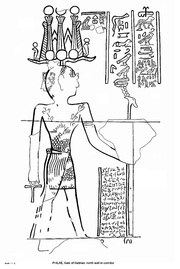Graffito of Esmet-Akhom
The Graffito of Esmet-Akhom (or Philae 436) is the last known inscription written in Egyptian hieroglyphs, dated to 394 CE. It is inscribed in the temple Isis at Philae in southern Egypt.[1]
The inscription consists of a hieroglyphic and a demotic part. The demotic part is dated to "the day of the Birth of Osiris, his (?) dedication-festival, year 110 [ Diocletian epoch ]", corresponding to 24 August 394. At the time, Roman Egypt had been largely Christianised, and Egypt was a separate diocese within the Praetorian prefecture of the East.
The figure on the left is meant to depict a king wearing a crown and the text in the top right is relating to a royal decree.[2]
The hieroglyphic inscription reads:
"Before Merul son of Horus, by the hand(?) of (?) Esmet-Akhom(?) son of Esmet, second prophet of Isis, for ever and ever. Words spoken by Merul, lord of Abaton, great god."[3]
The demotic inscription reads:
"I Esmet-akhom, the scribe of the house of record(?) of Isis, son of Esmet-Panekhate the second prophet of Isis and his mother Eswe-re; I performed work on this figure of Mandulis for everlasting, because he is kindly of face(?) unto me. To-day, the day of the Birth of Osiris, his (?) dedication-festival, year 110."[3]
.jpg)

.jpg)
.jpg)
References
| Wikimedia Commons has media related to Graffito of Esmet-Akhom. |
- ↑ "THE ANCIENT EGYPTIAN LANGUAGE: NOT JUST HIEROGLYPHS". American Research Center in Egypt Orange County. Retrieved 2015-04-26.
- ↑ Aswan - Last Hieroglyphic Text
- 1 2 Frank R. Trombley (1995). Hellenic Religion and Christianization: C. 370-529. Brill. p. 228. ISBN 9789004096912. google books preview
